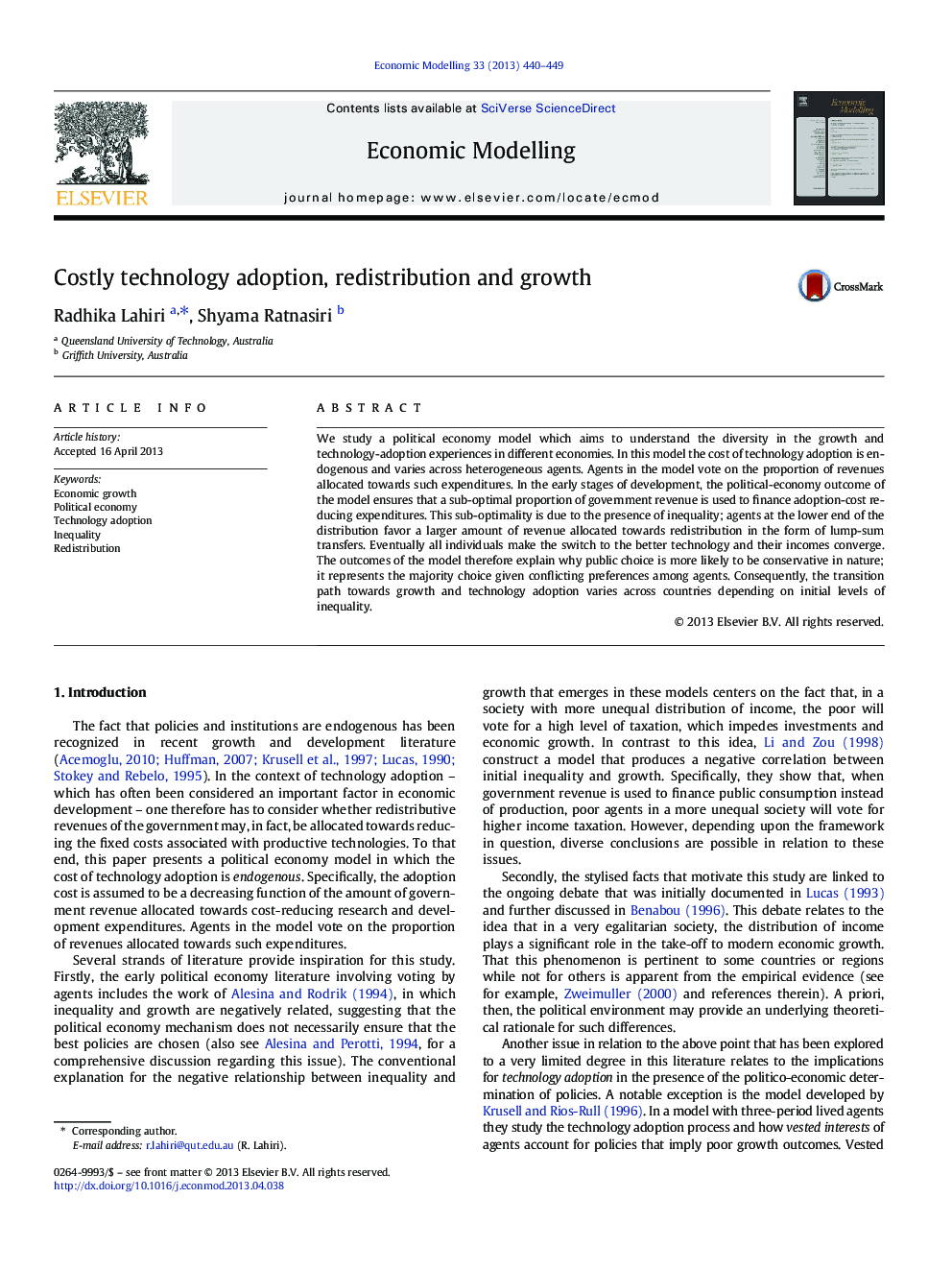| کد مقاله | کد نشریه | سال انتشار | مقاله انگلیسی | نسخه تمام متن |
|---|---|---|---|---|
| 5054470 | 1476535 | 2013 | 10 صفحه PDF | دانلود رایگان |
عنوان انگلیسی مقاله ISI
Costly technology adoption, redistribution and growth
ترجمه فارسی عنوان
اتخاذ فن آوری پرهزینه، توزیع مجدد و رشد
دانلود مقاله + سفارش ترجمه
دانلود مقاله ISI انگلیسی
رایگان برای ایرانیان
کلمات کلیدی
رشد اقتصادی، اقتصاد سیاسی، پذیرش فناوری، نابرابری، توزیع مجدد،
ترجمه چکیده
ما یک مدل اقتصاد سیاسی داریم که هدف آن درک تنوع در تجربیات رشد و تکنولوژی در اقتصادهای مختلف است. در این مدل هزینه اتخاذ تکنولوژی درونی است و در میان عوامل ناهمگن متفاوت است. نمایندگان در مدل رای دادن نسبت درآمد اختصاص داده شده به سمت چنین هزینه. در مراحل اولیه توسعه، نتایج سیاسی و اقتصادی مدل، تضمین می کند که بخش غیرمتمرکز درآمد دولتی برای تامین هزینه های کاهش هزینه های تصویب استفاده می شود. این کم اهمیت به دلیل وجود نابرابری است؛ نمایندگان در انتهای پایین توزیع، مبلغی بیشتر از درآمد اختصاص یافته به توزیع مجدد را به صورت یکپارچگی پرداخت می کنند. در نهایت همه افراد سوئیچ به فناوری بهتر و درآمدشان همگرا می شوند. نتیجه مدل به این دلیل است که چرا انتخاب عمومی بیشتر به طبیعت محافظه کارانه است. این نشان دهنده انتخاب اکثریت با توجه به ترجیحات متضاد میان عوامل است. در نتیجه، مسیر گذار به سوی رشد و تطبیق تکنولوژی در کشورهای مختلف بسته به سطوح اولیه نابرابری متفاوت است.
موضوعات مرتبط
علوم انسانی و اجتماعی
اقتصاد، اقتصادسنجی و امور مالی
اقتصاد و اقتصادسنجی
چکیده انگلیسی
We study a political economy model which aims to understand the diversity in the growth and technology-adoption experiences in different economies. In this model the cost of technology adoption is endogenous and varies across heterogeneous agents. Agents in the model vote on the proportion of revenues allocated towards such expenditures. In the early stages of development, the political-economy outcome of the model ensures that a sub-optimal proportion of government revenue is used to finance adoption-cost reducing expenditures. This sub-optimality is due to the presence of inequality; agents at the lower end of the distribution favor a larger amount of revenue allocated towards redistribution in the form of lump-sum transfers. Eventually all individuals make the switch to the better technology and their incomes converge. The outcomes of the model therefore explain why public choice is more likely to be conservative in nature; it represents the majority choice given conflicting preferences among agents. Consequently, the transition path towards growth and technology adoption varies across countries depending on initial levels of inequality.
ناشر
Database: Elsevier - ScienceDirect (ساینس دایرکت)
Journal: Economic Modelling - Volume 33, July 2013, Pages 440-449
Journal: Economic Modelling - Volume 33, July 2013, Pages 440-449
نویسندگان
Radhika Lahiri, Shyama Ratnasiri,
